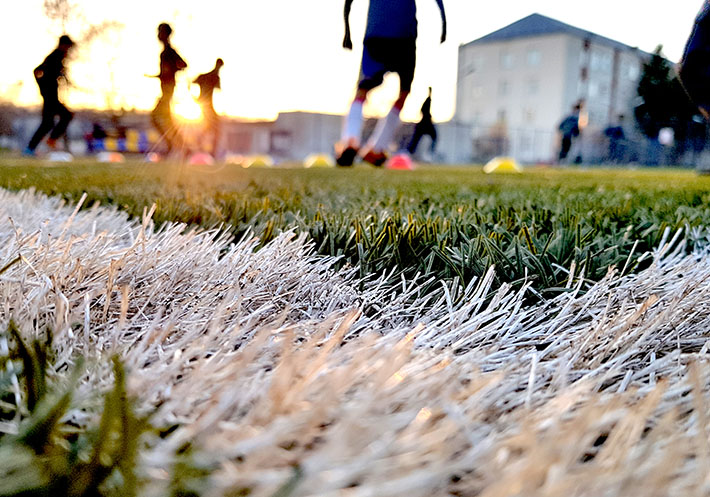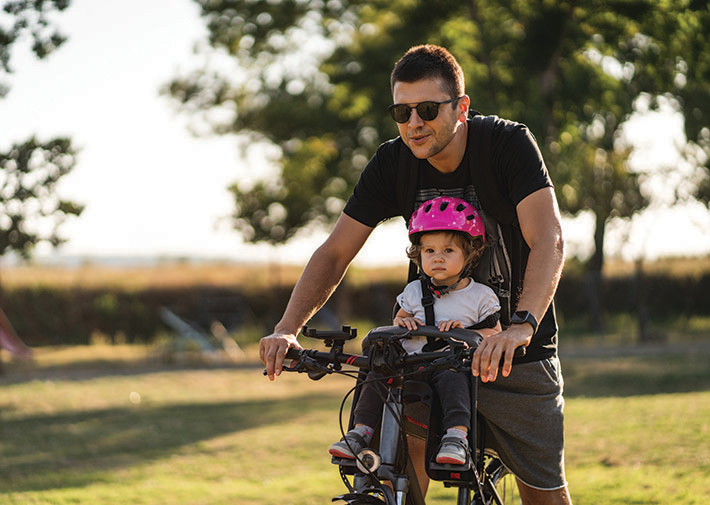Safer Sports and Play

Safer Sports and Play
As spring returns to the northern hemisphere, so, too, do enjoyable outdoor pursuits. Gone are the laborious tasks of raking leaves, scraping ice, and shoveling snow, replaced by cycling, jogging, and numerous organized sports. While these outside activities are healthy and fun, they are not without risk. According to the National Hospital Ambulatory Medical Care Survey released by the U.S. Centers for Disease Control in 2014 and 2019, 34 percent of all U.S. emergency room visits occur in the spring, with injuries accounting for 20 percent of all hospital trips. Yearly, over 2.7 million injuries sustained by patients aged 5 to 24 are attributed to sports such as football, cycling, basketball, and skating and skateboarding.
Helping to make sports and play safer (and reduce emergency room visits) is a key goal of ASTM International’s committee on sports equipment, playing surfaces, and facilities (F08). Founded in 1969, the 600-member group has 29 subcommittees devoted to such areas as bicycles, gymnasium rigging, and artificial turf and natural playing surfaces. Its subcommittees work to develop standards that lessen the intrinsic risk of injury from participating in sporting activities.
“We’re not making things safe,” says committee chair John Amato. Amato is a professional engineer and the owner of JJA Sports, a consulting firm specializing in athletic and recreational facilities. “We’re making things safer and improving the quality of play by reducing the risk of injury.”
Cycling Securely with Young Children
In much of the world, the COVID-19 pandemic sparked what the British Broadcasting Corporation (BBC) and other news outlets have referred to as “the great bicycle boom of 2020,” a tremendous increase in the sales and use of bicycles for exercise, pleasure, and commuting. In the U.S. alone, leisure bike sales increased 121 percent from March 2019 to March 2020. The New York Times reported that, during the same period, trail ridership increased threefold. And with more families riding the streets and trails together, more people were purchasing and installing bicycle child carriers. However, not every child bike seat possesses the same level of quality and safety. This is where the work of the subcommittee on bicycles (F08.10) proves invaluable.
FOR YOU: Playing Hardball with Standards
The bicycle subcommittee already has a standard in place for carriers that sit on the backs of bikes: the standard specification and test method for rear-mounted bicycle child carriers (F1625). The standard requires, among other things, that the rear-mounted child carrier include a rear reflector, backrest, footrests, armrests, protective devices to prevent the child’s hands and feet from contacting moving or movable components, and a belt or harness to keep the child from standing up or exiting the carrier. It is applicable to carriers holding up to 18 kilograms or 40 pounds.
“The current standard for rear bike seats is great and outlines everything you need to do to comply when your child is traveling on the back of the bike,” says Tom Hayward, general manager and cofounder of New Zealand’s Kids Ride Shotgun and an F08.10 member. “Over the last 10 to 15 years, though, the invention of products that allow the child to ride in the front of the bicycle has grown significantly. With the rear bike seat, interaction between you and the child isn’t that heavy. Riding with your kid up front, between you and the handle bars, you have a better connection.” He adds that, with rear-mounted child carriers, the child spends a good deal of time looking at the parent’s back, while, with front-mounted carriers, the child can experience nature and the pleasures of cycling more.
To address the use of front-mounted bicycle child carriers, the subcommittee has created two work items, the specification for front-mounted bicycle child carriers – engaged (WK84310) and the specification for front mount bicycle child carriers – restrained (WK84312). The work item for engaged bicycle seats pertains to carriers for children with a minimum weight of 12 kilograms (26.5 pounds) and a maximum weight of 27 kilograms (60 pounds). Generally, these bike seats suit children from the ages of two to five. They enable children to hold onto their own handlebars and learn how to steer and ride a bicycle.
Restrained or passive child bike seats have slightly different requirements than engaged carriers and are covered by the new specification for front mount bicycle child carriers – restrained. With a restrained bike seat, the child’s weight range is from 9 kilograms (19 pounds) to a maximum of 15 kilograms (33 pounds). In this type of carrier, the child is a passive passenger, safely strapped in and supported by a three- or five-point harness with legs and feet enclosed.
Both proposed standards will fill a gap in the bicycle child-carrier industry. Currently, F1625 exists for but no standard exists for front-mounted carriers.
“With COVID and the need to stay in your bubble, riding with your kids became quite popular,” says Heyward. “When something becomes popular, you end up with different variations of designs and quality entering the market. Some of the low price-point products challenge the boundaries of safety and appropriateness. They haven’t gone through the same design and testing process. We’re trying to hold them to materials, safety, and testing standards to make sure that people are actually getting a quality product that is designed for purpose rather than being copied and just put onto the market.”
 New proposed standards will help fill a gap in the bicycle child-carrier industry.
New proposed standards will help fill a gap in the bicycle child-carrier industry.
Uniform Sampling of Synthetic Playing Surfaces
Ensuring that turf owners and athletes of all ages have a consistent, quality playing surface falls under the purview of the subcommittee on artificial turf surfaces and systems (F08.65).
Presently, the subcommittee is in the process of balloting the test method for full depth field sampling of synthetic turf infill materials (WK73271). The standard will cover how synthetic turf material is to be collected, removed from the field, stored, and the locations on a field where sampling should occur.
Collecting the sample is a straightforward process. “You have a tube that gives you a limit and the walls of your sample a vertical. Then you have a probe for loosening the infill and a vacuum for collecting it. This gives you a true measure of what you’re sampling,” says Amato, who in addition to being the chair of F08, belongs to the subcommittee on artificial turf surfaces and systems (F08.65) and natural playing surfaces (F08.64).
He notes that there are a variety of infill materials used in synthetic turf fields. “Understanding how they apply and what’s working and not working is much easier when you have a consistent way of sampling,” he says.
Sand, coconut fiber, cork, ground wood, ground olive pits, and recycled chrome rubber are among the infill materials being utilized. Of these, sand and recycled chrome rubber most commonly appear in synthetic-turf installations. Like all infill, they improve impact absorption, provide ballast for artificial grass, and aid in water drainage. Although the most obvious places for synthetic turf would be football, soccer, and baseball fields, it also appears in dog parks, playgrounds, housing subdivisions, and town or city parks where regular turf grass cannot be maintained.
There are a range of reasons for testing synthetic turf. The simplest is that, when installing a turf field containing 300,000 to 400,000 pounds of material, buyers want to know what they’ve paid for, Amato says. Flooding is another reason.
“If a field floods and gets silt on it, by sampling, you could accurately evaluate the conditions and silt on the field and design a program to mitigate it,” he explains. “The ideal and most important applications deal with injuries and legal situations. Two opponents in a case may sample in different ways and get different results. By having a proper sampling method, both parties can accurately assess the materials. It brings a uniformity to the industry that doesn’t exist right now.”
Subcommittee on Gymnasium Safety
Not every group within F08 deals with outdoor activities. Formed in 2019, the subcommittee on commercially-installed sports-specific equipment for use in public venues (F08.69) looks at the manufacturing and maintenance sides of gymnasium rigging. The creation of this subcommittee stems from a tragedy involving a collapsing basketball backstop in a U.S. high school. A backstop consists of the hoop, backboard, and all the supports and rigging required to maintain stability, and can be ceiling- or wall-mounted.
READ MORE: Safety Is the Goal
“We [backstop manufacturers] all came together to discuss best practices as manufacturers and how to implement them and get someone to follow them,” says Neal Turner, director of gymnasium products at Draper. Turner is also a member of the subcommittees on gymnasium rigging (F08.69), sports facilities (F08.66), and gymnastics and wrestling equipment (F08.12).
“We decided to go to a body like ASTM and get a standard that we can hand to specifiers that says: ‘This is what a backstop should consist of. This is the way it should be made, and this is the way it should be installed.’ We knew what we should do, but the question was: ‘How do you get someone to enforce or promote it?’”
The subcommittee has three work items currently in progress: terminology for relating to commercially-installed sports-specific equipment for public venues (WK78953); specification for ceiling and wall suspended basketball backstops (WK70498); and the guide for service and maintenance of ceiling and wall suspended basketball backstops (WK70499). The new specification focuses on the manufacturing side of basketball backstops and the inclusion of such items as a safety strap – which protects against cable failure and prevents things from falling – and safety bolts. Turner notes that, if something is not specified, a manufacturer might omit it as a cost-saving measure.
The new guide concentrates on the maintenance of basketball backstops, how frequently they should be inspected, and what should be inspected. The guide will also cover replacement of the equipment, with those who maintain and service backstops referencing this guide. At present, no such manual exists. In the future, Turner anticipates that the subcommittee will create a standard on the installation of backstops and who should install such equipment.
“We’re still in our infancy, and a lot of members are new to ASTM,” he says. “The tools and resources provided by ASTM have been a big help to us. Creating standards is a way to leave a mark on the industry. It’s had a good record but we want to make it better.”
For additional information about committee on sports equipment, playing surfaces, and facilities (F08) and how to become involved with its work, contact staff manager Joe Koury at: jkoury@astm.org.■
Kathy Hunt is a U.S. East Coast-based journalist.